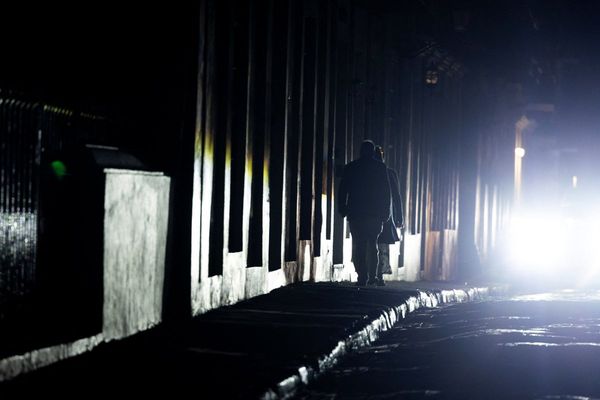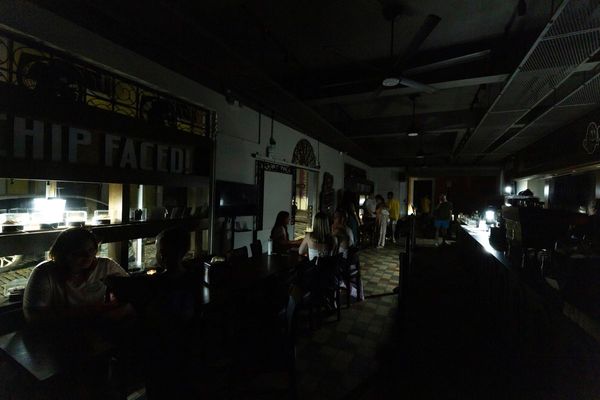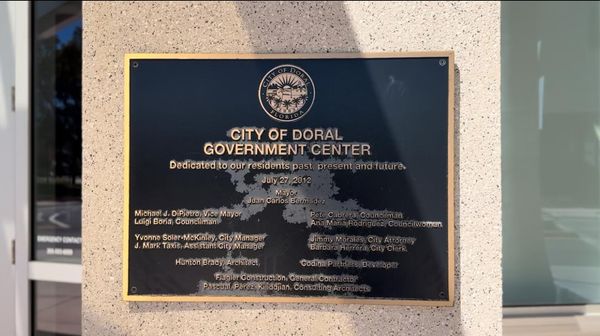
Fans of Pete Davidson who tuned in to watch him host Saturday Night Live were disappointed to find a rerun instead. Viewers of Stephen Colbert, Jimmy Fallon and Jimmy Kimmel found they too had gone dark. While late-night TV had found ingenious ways to stay on air during a global pandemic, this was different.
It was a year ago this month that screenwriters hit the picket lines. Actors followed suit with a walkout in mid-July, the first time that the two unions had been on strike together since 1960. As Hollywood came to a standstill, studios were forced to the negotiating table on issues including minimum pay, streaming residuals and guardrails against the use of artificial intelligence (AI).
The Writers Guild of America (WGA) and Screen Actors Guild–American Federation of Television and Radio Artists (Sag-Aftra) reached deals that ended the strikes on 26 September and 9 November, respectively. Studios raced back into production and stars returned to red carpets. But the sense of relief and joy was tinged with trepidation, a sense that there is no going back to the old normal.
“I don’t know what normal is any more,” says Jared Butler, a screenwriter and voice actor. “I don’t feel like I’ve gone back in a time machine to a better time in Hollywood, but precisely when that started to fall apart is hard to pinpoint. I would say labour won the strike but there’s a difference between being satisfied with that and feeling happy about the current state of the business. It’s easy to get the two things mixed up.”
The actors and writers who secured better pay are also finding themselves competing for fewer jobs. That is because Hollywood’s summer of labour unrest, which caused an estimated economic loss of $6bn, was likely a probably in a wider slowdown. The entertainment industry, still recovering from aftershocks of the coronavirus pandemic, is in the throes of a painful transformation.
The circumstances that brought on the strikes – the shift from traditional theatrical and broadcast media to streaming, and emerging tech like AI – have not gone away. That includes the so-called streaming wars, a helter-skelter rush to make content for platforms such as Netflix, Apple TV+, Disney+ and Max that scrambled economic models.
Even before the strikes, every studio was reassessing its streaming strategy. Most are downsizing after several years of rampant spending, cutting staff and striving for profitability. Series production dipped last year after reaching an all-time high in 2022, when 599 original series were made. After a glut of Marvel and Star Wars, Disney has said it will focus on quality rather than quantity.
David Scarpa, who wrote the screenplay for Napoleon, directed by Ridley Scott for Apple TV+, says: “In general the business is a little slower coming out of the strike and everybody has observed this. The industry was in a bit of a slump going into this and the strike sort of punctuated that.
“There was a huge spending binge on the part of the streamers to gain market share for the past several years leading up to the strike. A big earnings report from Netflix signalled that time was coming to an end. The strike underscored that and my impression from people that I’ve spoken to, and from my own experience, is that deals are taking longer to close and that there’s just simply less out there than there was previously.”
Hollywood strikes have tended to come in the wake of major technological upheavals. This time it was AI and its potential to replace human labour. The 11,500-member WGA secured a deal that requires studios and production companies to disclose to writers if any material given to them has been generated by AI. AI cannot be a credited as a writer, AI cannot write or rewrite “literary material”, and AI-generated writing cannot be source material. Writers can choose to use AI but cannot be compelled to do so.
The guardrails seems to be working, at least for now. Scarpa comments: “There was more panic about it at the time a year ago, more of a sense that AI was coming to take everybody’s jobs. People are starting to become a little bit more balanced on the topic.
“I hear a lot less about AI now in terms of how it impacts writers or will impact writers than I did a year ago and I hear more scepticism about the extent to which it’s going to replace writers. It’s going to have an impact but ultimately it’ll be more of a tool rather than something that’s been completely [used to] replace everybody in the industry.”
On the acting side, AI has already been used to de-age performers and could potentially replace them or their voices. Sag-Aftra, with a membership of 160,000 film and TV actors, stunt performers and other media professionals, secured provisions that say the studios and streamers cannot use AI or digital replications without the informed consent of the performer.
Some actors remain unsatisfied and complained that the union made too many concessions. But Duncan Crabtree-Ireland, Sag-Aftra’s national executive director and chief negotiator, believes it got the best possible deal in what remains uncharted territory – even the federal government is grappling with AI policy and trying to play catch-up.
He says: “There were some of our members who would have preferred that we somehow prohibit or block AI. I don’t think that was achievable and I don’t think it’s a good strategy to pursue that approach and so I believe what we did was right. Our contract was ratified by about 80% of our members so I think that’s a sign that the members were broadly satisfied. Since this deal, we’ve now made several subsequent deals involving AI, for example, in television animation.”
The contract leaves actors well placed for the future, argues Crabtree-Ireland. “It would have been entirely possible for us to be behind the curve on AI but we were not. We spent years studying it before this negotiation. We were prepared for it. We came into the negotiation with a series of very concrete and specific proposals. We achieved the vast majority of what we put forward and that’s because we were looking around the bend in the road.
“A lot of the AI technology implementation hasn’t even happened yet but our contracts are there ready for it. I feel like a lot of times unions get criticised for being too reactive, not being proactive, looking to the future, and I think this is real evidence we can be proud of not doing that. In fact, we have looked to the future and we correctly calibrated our marketing and all of our leverage to ensure that the kinds of provisions that we have in place are designed to protect our members as this technology moves forward.”
Another central issue in Sag-Aftra’s negotiations with the Alliance of Motion Picture and Television Producers was the union’s attempt to win a percentage – 1% or 2% – of streaming revenue, to replace lost residuals. In the end, the actors accepted a bonus tied to viewership. It was a reminder that collective bargaining is always a compromise.
Mary Flynn, who was a Sag-Aftra strike captain for the Netflix picket line, says: “The thing that most people don’t consider in negotiations is that both sides come out losing in some regard. Is the contract absolutely perfect with everything Sag-Aftra and the WGA wanted? No. That’s the nature of bargaining.
“Especially with the public’s understanding about AI, because we didn’t get an all-out ban, a lot of people responded negatively to that. The residuals for what used to be considered new media, like Netflix or streaming, are still not quite where I want them to be. But overall I voted yes on the contract. I was happy with it, especially for how long it’s been. Was it perfect? No, but I think it’s the best it was going to be.”
The strikes also challenged Hollywood power structures, winning gains for actors and writers and rallying union support throughout the industry. The International Alliance of Theatrical Stage Employees and the Teamsters, two unions representing Hollywood crew members, are now in contract negotiations with the studios.
Flynn explains: “It forced so many people who were complacent in the union activism side of it to get involved and tipped the underside of the industry to show the exploitation. It made people wake up. The pandemic started that but this added to that fuel that was already there.
“I know a lot of our strike captains are getting way more involved internally with the unions, whether going to solidarity events or sitting on committees, myself included, to be able to get more involved. We raise the bar for workers, we raise the bar for all workers. So when WGA and Sag-Aftra go on strike, we’re setting a precedent with the studios to get better deals for the other workers in the industry.”
Kieren van den Blink, a Sag-Aftra member since 1997 who joined the picket lines at several studios, feels a sense of empowerment. “It was tremendously galvanising and that pride I felt when I was a kid fresh out of college is back,” she says, recalling how she approached two men at a sandwich restaurant during the strike because they were wearing union shirts.
“If we weren’t striking, I would never walk up to two random men at a restaurant and be like, I’m an actor; I would come off as a maniac. I felt such community and I was excited to chat with them about: ‘Where were you picketing? We were at Paramount, where were you?’ It felt good.”
Van den Blink adds: “I definitely feel like I rediscovered a nobility as an actor and part of that is the fact that we stood in solidarity and stood strong and didn’t let up and had strong, powerful, brave leadership, which I don’t think we’ve had for a while. We grew and we strengthened as a result of it. There was a hit – there have been fewer jobs and people have felt it profoundly. The gain is more long term but there’s value to the gain as well. The gain is real.”
The fight goes on. Sag-Aftra is now negotiating a contract for video game actors who could go on strike in a month or six weeks if an agreement is not reached. The TV and film actors’ contract will be up for renewal in 2026 with issues such as AI potentially flaring up again. But nothing is likely to compare with the events of last summer as a watershed that continues to reverberate well beyond Hollywood.
Crabtree-Ireland of Sag-Aftra reflects: “It felt like a historic moment. It felt like we and the writers were both fighting for something that was important. When we look back on it five years from now, 10 years from now, we will still believe that it was the right decision to handle it the way we did and, even though the strike was hard and resulted in a lot of disruption to the industry, it was necessary and ultimately achieved things that were worth the cost.”







